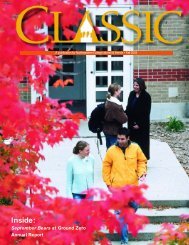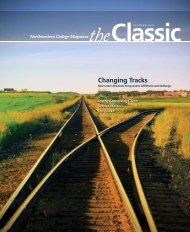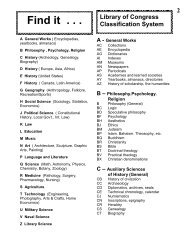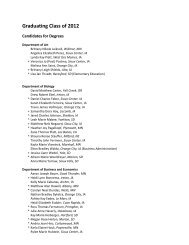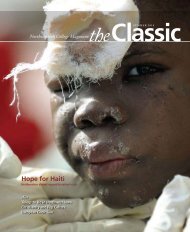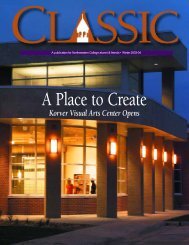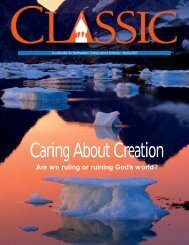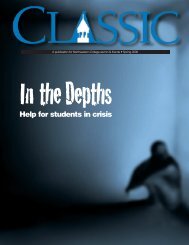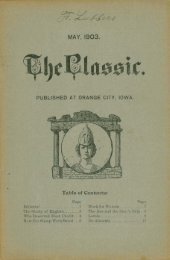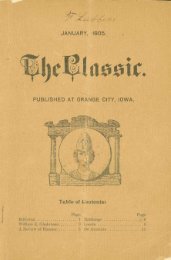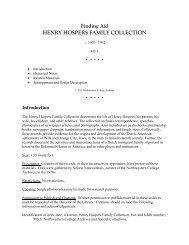Summer 2007 - Northwestern College
Summer 2007 - Northwestern College
Summer 2007 - Northwestern College
You also want an ePaper? Increase the reach of your titles
YUMPU automatically turns print PDFs into web optimized ePapers that Google loves.
<strong>Northwestern</strong> Classic<br />
Classicthoughts<br />
A Breath of Life in Argentina<br />
by Andrea (Collier ’07) Helmus<br />
When I first came to Buenos Aires<br />
to study abroad last fall, I thought I<br />
would go crazy from the buses rumbling<br />
up and down our street all night,<br />
the honking taxis, the barking dogs<br />
(everyone has a dog), and waking up to<br />
the sound of a jackhammer every morning.<br />
Moments of complete silence were<br />
rare, which is why I was struck by the<br />
quiet at the art exhibit. An utter contrast<br />
from the noisy, colorful park outside,<br />
the mood inside the exhibit was<br />
thoughtful and solemn. The exhibit’s<br />
title was what had intrigued my friend<br />
and me, and as we entered the exhibit<br />
commemorating “The Disappeared” of<br />
Latin America and Argentina, we understood<br />
the reason for the silence.<br />
During the 1970s, Argentina suffered<br />
under a brutal military dictatorship<br />
that targeted its own citizens as the<br />
enemy. It is estimated over 30,000 people<br />
disappeared between 1976 and<br />
1983. They were kidnapped, tortured<br />
for information, and killed. Thirty years<br />
later, only a handful of people have been<br />
tried for the crimes committed, and the<br />
families of the disappeared (desaparecidos)<br />
still do not know what happened<br />
to their loved ones.<br />
Ever since my freshman year at<br />
<strong>Northwestern</strong>, I have been drawn to<br />
Argentina. I entered college as a Spanish<br />
major, and one day while digging<br />
through the stacks in Ramaker Library, I<br />
came across a book about Argentina’s<br />
dictatorship. Once I started reading it, I<br />
realized my life would be changed, yet<br />
at the time I had no idea how profoundly.<br />
One thing was certain: I was hooked<br />
on Argentina.<br />
Another Spanish major, Becky<br />
Johnson ’06, and I joined the students at<br />
the Universidad de Belgrano in Buenos<br />
Aires last fall and moved in with a señora<br />
named Marta. Our exploration of the city<br />
allowed us to experience the things we<br />
learned in class and read about in our<br />
textbooks. Evita’s black marble tomb,<br />
accordion music at late-night tango<br />
shows, and the mothers of the desaparecidos<br />
who march every Wednesday afternoon<br />
in memory of their missing children<br />
were the images that lent shape to the<br />
ideas in my head.<br />
It was a true privilege to learn<br />
about Argentina’s history from professors<br />
who lived through it. My sociology<br />
professor had nearly been a desaparecido<br />
herself. Arrested once, she was fortunate<br />
enough to be released, but I remember<br />
hearing her voice shake when she talked<br />
about the dictatorship.<br />
The art exhibit was yet another<br />
instance when the facts of history<br />
became personal.<br />
The artists, many of them friends<br />
and family members of desaparecidos,<br />
earnestly tried to speak for the missing<br />
who could not speak for themselves. The<br />
works in the exhibit ranged from haunting<br />
to hopeful—from childhood photos<br />
of one artist’s disappeared younger brother<br />
(they are play-fighting with toy bows<br />
and arrows on the front lawn) to spraypainted<br />
silhouettes of bicycles that call to<br />
mind their stolen riders.<br />
One of my favorite works involved<br />
small polished steel circles. Artist Oscar<br />
Muñoz had engraved each shiny circle<br />
with a photo of his disappeared friends<br />
in Colombia. The photos were invisible<br />
until I got close enough to breathe on the<br />
steel. My warm breath caused the faces to<br />
emerge in the condensation. The face of<br />
someone I had never known—and never<br />
will because of injustice—stared back at<br />
me amid my own reflection.<br />
Muñoz said it best: “The viewer<br />
gives life [to the disappeared] with his<br />
or her own breath … and the face of the<br />
dead is transformed into poetry by this<br />
simple act of human attention.”<br />
I found truth in Muñoz’s words that<br />
day. I often think about why God gave<br />
me this desire to study Argentina and<br />
understand its troubled past. I wonder if<br />
each one of us is called to somehow do<br />
as God did when he created humans,<br />
and breathe life into the earth.<br />
Our world is confusing and<br />
painful, chaotic and scary, but as<br />
Christians, we can be instruments of<br />
beauty, truth and—most of all—<br />
redemption. With God’s help and guidance,<br />
we can breathe his life into the<br />
world’s darkest corners.<br />
Andrea Helmus’ study abroad experience<br />
was preceded by a <strong>Summer</strong> of Service in<br />
Argentina with World Gospel Mission. She<br />
hopes to continue studying the country as<br />
she pursues a master’s degree in Latin<br />
American studies at the University of<br />
Arizona.<br />
Send your Classic thoughts to classic@nwciowa.edu<br />
39 ▲ <strong>Summer</strong> <strong>2007</strong>



